Water Saving
- Animals, Bees, Birding, Building and Landscaping, Chickens, Cob, Compost, Composting toilet, Fungus and Mushrooms, Gardening adventures, Giving, Health, Heirloom Plants, Hiking, Houses, Hugelkultur, Humor, Living structures, Natives, Natural cleaners, Other Insects, Permaculture and Edible Forest Gardening Adventures, Pets, Photos, Predators, Quail, Rain Catching, Recycling and Repurposing, Reptiles and Amphibians, Seeds, Soil, Vegetables, Water Saving, Worms
Special Tours for Aug. and Sept., 2014
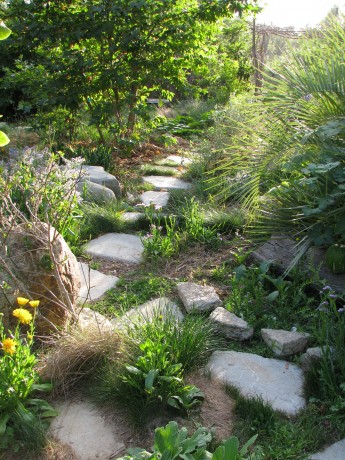
Come take a tour of a food forest! Normally tours of Finch Frolic Garden are held by appointment for groups of 5 – 15 people, Thursdays – Mondays. Cost is $10 per person and the tour lasts about two hours. By popular demand, for those who don’t have a group of five or more, we will be hosting Open Tour days for the first 15 people to sign up in August and September. They will be Sunday, August 10 and 24, Sept. 7 and 21, and Thursdays August 7 and 28, and Sept. 11 and 25. Tours begin promptly at 10 am. The tours last about two hours and are classes on basic permaculture while we tour the food forest. I ask $10 per person. Please reserve and receive directions through dianeckennedy@prodigy.net. Children under 10 are free; please, no pets. Photos but no video are allowed. Thank you for coming to visit! Diane and Miranda
- Animals, Bees, Birding, Books, Building and Landscaping, Chickens, Cob, Compost, Composting toilet, Fungus and Mushrooms, Gardening adventures, Heirloom Plants, Hugelkultur, Humor, Living structures, Natives, Natural cleaners, Other Insects, Permaculture and Edible Forest Gardening Adventures, Ponds, Predators, Quail, Rain Catching, Recycling and Repurposing, Reptiles and Amphibians, Seeds, Soil, Water Saving, Worms
Permaculture Lectures At Finch Frolic Garden, June 2014
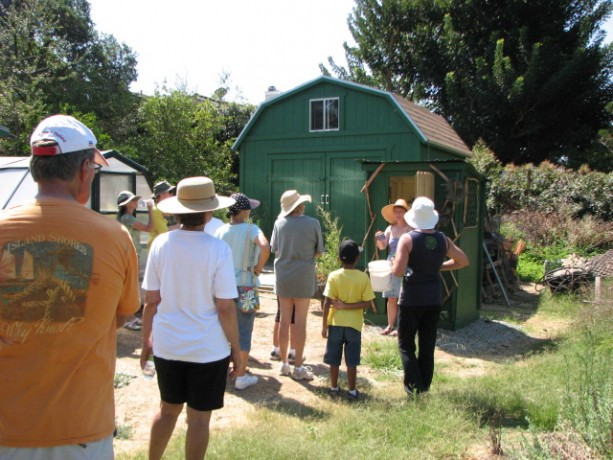
Tour Finch Frolic Garden! Permaculture Lectures in the Garden!
Learn how to work with nature and save money too
Finch Frolic Garden and Hatch Aquatics will present four fantastic, information-filled lectures in June. Join us at beautiful Finch Frolic Garden in Fallbrook, 4 pm to 6 pm, for refreshments and talks on…
Saturday, June 7: Introduction to Permaculture and Finch Frolic Tour: We’ll take you through the main precepts of permaculture and how it can be applied not only to your garden, but to yourself and your community. Then we’ll tour Finch Frolic Garden and show rain catchments, swales, plant guilds, polyculture, living buildings and so much more.
Saturday, June 14: Your Workers in the Soil and Earthworks: Learn the best methods for storing water in the soil and how to replace all your chemicals with actively aerated compost tea and compost.
Saturday, June 21: Aquaculture: You can have a natural pond – even in a tub! How natural ponds work, which plants clean water and which are good to eat. Even if you don’t want a pond, you’ll learn exciting information about bioremediation and riparian habitat.
Saturday, June 28: Wildlife in your Garden: What are all those bugs and critters and what they are doing in your yard? We’ll discuss how to live with wildlife and the best ways to attract beneficial species.
Your hosts and lecturers will be
Jacob Hatch Owner of Hatch Aquatics. With years of installing and maintaining natural ponds and waterways, and a Permaculture Design Course graduate, Jacob has installed earthworks with some of the biggest names in permaculture.
Miranda Kennedy OSU graduate of Wildlife Conservation and wildlife consultant, Miranda photographs and identifies flora and fauna and maps their roles in backyard ecosystems.
Diane Kennedy Owner of Finch Frolic Garden, lecturer, consultant, Permaculture Design Course graduate, former SDC Senior Park Ranger, Diane educates homeowners on how to save money and the environment while building their dream gardens.
Each class limit is 50 attendees, so please make pre-paid reservations soon before they fill up. Fee for set of four lectures and tour is $45 per person. Single session fee is $20 per person. Contact Diane Kennedy at dianeckennedy@prodigy.net for reservations and directions.
You will not want to miss this fascinating and useful information!
- Building and Landscaping, Compost, Fungus and Mushrooms, Gardening adventures, Heirloom Plants, Hugelkultur, Natives, Permaculture and Edible Forest Gardening Adventures, Rain Catching, Seeds, Soil, Water Saving
The Albedo Effect: How Bare Earth Causes Wild Weather
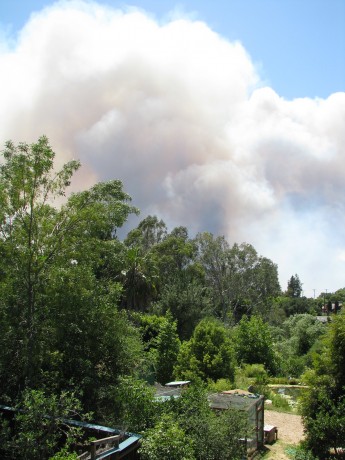
This week’s 100F+ temperatures and high Santa Ana winds have fueled three fires close to us. It is May, not October. Albedo is a reflection coefficient. In layman’s terms it is the effect that happens when sunlight is reflected off of white areas. There is the high albedo of bare earth, snow and ice, and clouds, and the low albedo of water and vegetation. There is less reflection from dark areas such as off of water and green areas, and darker areas, just like dark clothing, absorbs more heat rather than reflects it like white clothing does. There are arguments that we should cut down all the trees to increase white space to stop global warming. NO! The plant life that occupies the green spaces transpire water and excess heat into the air, causing cloud cover. Clouds, of course, insulate the earth from the sun and their albedo effect is cooling to the earth, not to mention that clouds amass moisture and – bingo – you get rain. It is the loss of green areas and the desertification of large masses of Africa, and the in-progress desertification of the already drier areas of the world (such as California) that makes the albedo effect one that is helping warm our climate. Great tracks of land now reflect light into cloudless skies; water sources dry up and plants die so transpiration disappears. The loss of air-borne water (evapotranspiration) allows areas around the desert area to also dry out. The rapid change of climate due to desertification, loss of topsoil and the resulting erosion and the melting of our ice caps (creating larger oceans and thus larger thermal masses to reflect heat) causes severe weather patterns – weather patterns that balance out huge dry desert areas with destructive rain and wind storms in other areas. Drying areas ignite… here in San Diego North County there are five fires burning as I sit, and heavy smoke and ash rain down on everything between them. My house is not threatened at this time, but we may be evacuated. So many people are evacuated right now and the highways are packed. There is another fire near San Diego, and two between here and Los Angeles. It is May – usually we have these temperatures, wild winds from the desert called Santa Ana winds, and fire threat in October. Our lack of rain doesn’t bode well for California.
My point is that to help balance nature out again, we need to hurriedly lessen the amount of reflected light in areas where we were traditionally covered by plants. We need to plant. We need to plant native plants. We need to re-green our landscapes, in each backyard and vacant lot, as quickly as we can. Allow the plants to keep moisture in the soil, to slow flooding, to transpire moisture into our atmosphere so that rain comes back to the desert areas. We need to hold what rain that falls in our soil by burying wood (hugelkultur), by creating level swales and mulching, mulching, mulching. Yet on trash day I see bags and bags of leaves set on the street ready to go to the dump. We need to stop erosion areas by using whatever means we can to keep the topsoil back. We need native trees with long roots that will hold the soil, build topsoil and transpirate.
Of course you probably can’t afford lots of plants, so plant natives that will quickly grow large. Between the slower-growing oaks, plant sages, mallows, ceanothus, quail bush and other bushes that cover 10 -15 feet of dry earth. Under them will be moisture, protected soil with mulch from their leaves, and habitat for lizards, frogs, small birds and hundreds of insects. These bushes will help shade young oaks, sycamores, and other trees and keep their trunks from scorching.
Throw down seeds of California fescue (Festuca californica var. parishii) to hold soil and cover the dry, reflective areas. This native grass is tough and doesn’t cause trouble like non-native grasses. You can seed it with California poppies, lupine and other native flowers. Aggressively weed out non-native species.
Since I was little, in the 60’s, I heard the mantra ‘plant a tree’. Obviously we haven’t been doing that. I think it should be changed to ‘plant a tree and don’t cut down any more because the earth can’t afford it’!
Please plant! And all my hope goes to you and yours who are threatened or have had losses from our severe weather.
- Animals, Compost, Fungus and Mushrooms, Gardening adventures, Permaculture and Edible Forest Gardening Adventures, Soil, Water Saving
Actively Aerated Compost Tea

Aerator, molasses, a paint strainer full of compost and a bucket of water. There are many teas for the garden. Manure tea is made by steeping… you guessed it… well-aged manure in water for several days. Well-aged is the key. Many years ago I gathered horse manure, made a tea and righteously spread it – and all the Bermuda grass seed that was in it – all over my vegetable garden. I’m still battling the grass. With fresh manure you are also brewing some nasty bacteria with which you really shouldn’t be dealing. Allowing well aged or composted manure to brew for a couple of days will produce a nice nutrient tea for your plants. There are better brews for your effort.
Plain compost tea is when you take samples of good soil and allow them to steep in water for several days and use that. This brew has some microbes and basic nutrients in it and is better than plain water for enhancing your soil and as a foliar spray.
However there is a super brew called actively aerated compost tea. It is very simple and inexpensive to make and it works wonders. There are many recipes for it, depending upon how analytical you want to become. Studying your soil under a microscope and following the advice of Dr. Elaine Ingham will give you the premium tea for your particular soil. Dr. Ingham and Dr. Carole Ann Rollins have many books out on the subject of microorganismsin the soil which are all fascinating and well worth the read; if you ever have the chance to hear Dr. Ingham speak, take it!
I don’t tinker with my tea at this time because I just don’t have the time for it. You may not, either. So this is the basic aerated compost tea recipe that will revitalize your soil:
You will need a 5-gallon bucket, a paint strainer or cheesecloth or an old sock, a fish tank aerator or air bubbler, and one or all of these: organic unsulphered molasses, organic flours, organic corn meal, kelp. I have had excellent luck with TeaLab’s Bubblesnake Compost Tea Brewer. I don’t get anything for the plug, I just found that the kit really works and is easy to buy. I purchased through AmazonSmile.

Fill the bucket with either rainwater or tapwater that has stood for at least a day for the chlorine to have evaporated.
Take the paint strainer or sock and fill it with samples of good soil from around your property. If you don’t have any good soil, then add the best you have and then take good soil from areas as close to your property as possible. If you will be using the tea on bushes and trees, then be sure to take soil from under the same. Woody plants like highly fungal soil. If you will be using the tea for annuals and veggies, then go heavy on fine, well-composted soil that is bacteria-rich. Do the best you can; you can’t go wrong unless you take soil that has been sprayed with chemicals, use treated wood chips, or anaerobic soil (you’ll smell it if you do).
Tie the top of the cloth and put it into the bucket. You may tie twine or something around it so that you can haul it out of the bucket if you’d like. This is important on larger containers, but not so much with the small bucket.
Place the aerator or bubbler in the bucket, making sure the air intake hose is clear, and plug it in.
Add about a half tablespoon of molasses. It is important that the molasses is unsulphered and organic for the same reasons that the water shouldn’t have chlorine in it or the soil any chemicals: those things will hurt the microbes that you will be growing. For growth of other microbes, add about a teaspoon of any or all of the following: organic cornmeal, organic wheat flour, liquid kelp, and if you have it tucked away in your shed, bonemeal and bloodmeal (otherwise don’t buy it specially!). So the more different foods you add, the less of each that you use. Two tablespoons of food is about all you want; don’t have a big glob of it floating in your bucket.
Allow the aerator to do its thing for about 13 hours. When its done it should look and smell like sweet tea. Use it within a couple of hours or the creatures will use up all the oxygen and it will go bad. There is much discussion about how long you brew it, etc., just as there are hundreds of stew recipes. This is the recipe taught me in my PDC and one I’ve heard elsewhere. If your tea smells bad, any hint of ammonia or ‘off’ smells, don’t apply it to your plants. You’ll be hurting them. Be sure you have good compost, fresh water and proper aeration, and don’t let it sit too long.
What you are making is not just tea, it is soil inoculant. The micororganisms in the compost will feed on the molasses and oxygen, reproducing until at about 13 hours their numbers will peak and begin dying off a little. The tea should be used within a couple of hours.
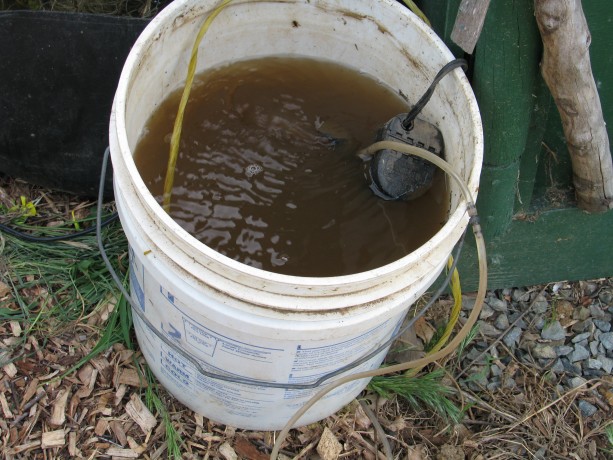
Brew the tea for 13 hours then gently apply as a soil drench or foliar spray. What this tea is doing when applied, is establishing or boosting the fungus, bacteria, amoebas, nematodes, and other soil inhabitants in your dirt, all of which are native to your particular area. If you have decent soil already, then you can use this tea 1:10 parts dechlorinated water. If you have rotten dirt, use it straight along with a topping of compost. Compost, whether it be cooked composed compost, straight leaf matter, shredded wood, logs, damp cardboard or natural fabrics, all provide shelter and hold moisture in so that your microbes have habitat. Compost, of course, is the best source of food, moisture and shelter for them.
Apply the tea with a watering can, or a sprayer that has a large opening for the nozzle if you are using the tea as a foliar spray. A squeeze-trigger bottle used for misting has too narrow an opening and will kill a lot of the little guys you have just grown.
Using the tea as a foliar spray will treat disease, fungus and nutrient deficiencies, and help protect plants against insect attack. Instead of spraying sulfur or Bordeaux solution on your trees as is preached by modern gardening books, use compost tea on the leaves and around the drip line. When applied to leaves, the plant’s exudates hold the beneficial microorganisms to the stomata or breathing holes protecting them from disease and many harmful insects. You can’t overdose with compost tea.
All the additives that are recommended to ‘improve’ your soil are bandages not solutions. Think of the billions of soft-bodied creatures living in your soil, waiting for organic matter to eat. Then think of the lime, the rock dusts, the gypsum, the sulfur, the NPK concentrated chemical fertilizers (even derived from organic sources), poured onto these creatures. It burns them, suffocates them and kills them. Your plants show some positive results to begin with because they’ve just received a dose of nutrients, both from what you applied and from the dead bodies of all those murdered microbes. However the problem still is there. The only long-term solution to locked-up nutrients in the soil, hard pan, heavy clay, sand, compaction, burned, or poisoned soil, is good microbe-filled compost. Remember that microbes turn soil into a neutral pH, and allow more collection of neutral pH rainwater. Nutrients in the soil all become available at a neutral pH; there is no such thing as an iron-deficient soil. The nutrients are just locked away from the roots because of the lack of microbes and the pH.
There are compost tea brewers of all sizes, and lots of discussion about how well they work and whether they actually kill off a lot of microbes. See Dr. Elaine Ingham’s work for discussion on different brewers. For large scale operations there are large tanks with aggressive aerators, and the tea is sprayed from the tanks from a truck bed directly on the fields. If you can’t compost your entire property, then spraying compost tea is the next best thing.
If you’d like to be more involved with the biology of your tea, see Qualitative Assessment of Microorganisms by Dr. Elaine Ingham and Dr. Carole Ann Rollins. This book has photos of different soil components as they appear under a microscope, identifying and explaining them. By studying your soil’s balance through a microscope and then tweaking your tea to compensate you’ll be making the most powerful soil inoculant you can.
- Animals, Bees, Birding, Chickens, Cob, Compost, Composting toilet, Fungus and Mushrooms, Gardening adventures, Health, Heirloom Plants, Hiking, Humor, Living structures, Natives, Natural cleaners, Other Insects, Permaculture and Edible Forest Gardening Adventures, Pets, Photos, Ponds, Predators, Quail, Rain Catching, Reptiles and Amphibians, Seeds, Soil, Water Saving, Worms
Finch Frolic Facebook!
Thanks to my daughter Miranda, our permaculture food forest habitat Finch Frolic Garden has a Facebook page. Miranda steadily feeds information onto the site, mostly about the creatures she’s discovering that have recently been attracted to our property. Lizards, chickens, web spinners and much more. If you are a Facebook aficionado, consider giving us a visit and ‘liking’ our page. Thanks!
- Animals, Bees, Birding, Compost, Fruit, Fungus and Mushrooms, Gardening adventures, Herbs, Hugelkultur, Natives, Other Insects, Permaculture and Edible Forest Gardening Adventures, Ponds, Predators, Rain Catching, Reptiles and Amphibians, Seeds, Soil, Vegetables, Water Saving, Worms
The Mulberry Guild
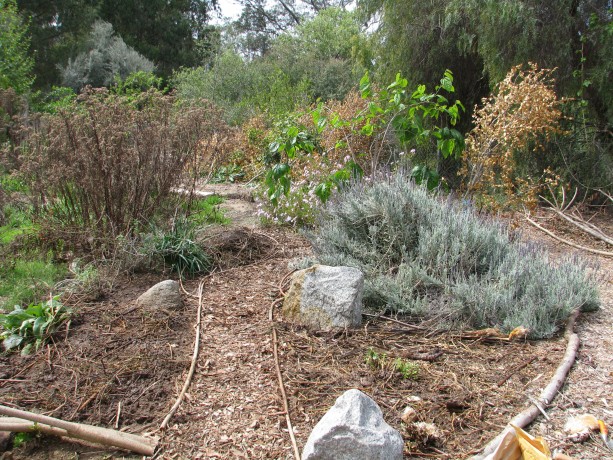
The renovated and planted mulberry guild. One of our larger guilds has a Pakistani mulberry tree that I’d planted last spring, and around it had grown tomatoes, melons, eggplant, herbs, Swiss chard, artichokes and garlic chives.
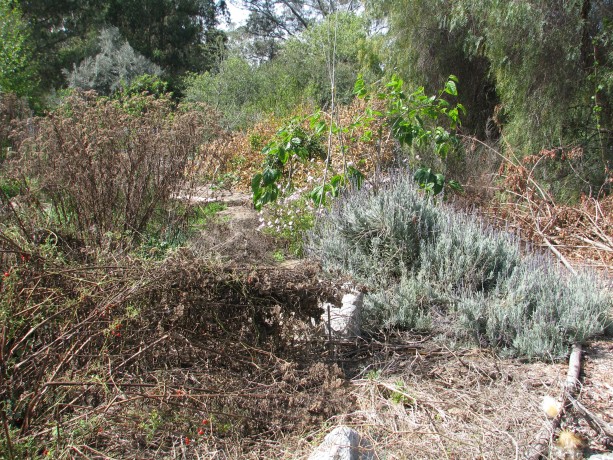
Mulberry guild with last year’s plant matter and unreachable beds. This guild was too large; any vegetable bed should be able to be reached from a pathway without having to step into the bed. Stepping on your garden soil crushes fungus and microbes, and compacts (deoxygenates) the soil. So of course when I told my daughter last week that we had to plant that guild that day, what I ended up meaning was, we were going to do a lot of digging in the heat and maybe plant the next day. Most of my projects are like this.
Lavender, valerian, lemon balm, horehound, comfrey and clumping garlic chives were still thriving in the bed. Marsh fleabane, a native, had seeded itself all around the bed and had not only protected veggies from last summer’s extreme heat, but provided trellises for the current tomatoes.
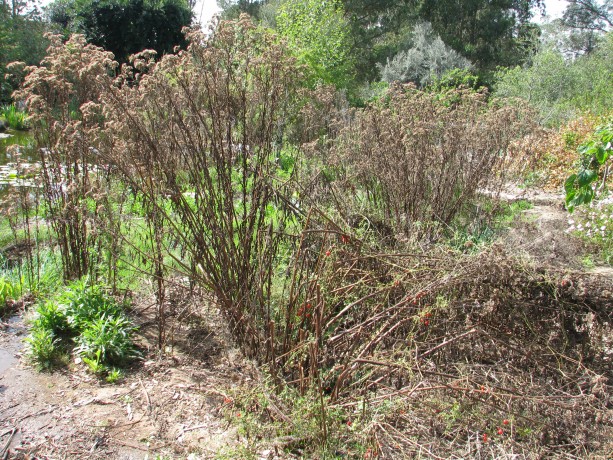
Fleabane stalks from last year, with new growth coming from the roots. Marsh fleabane is an incredible lure for hundreds of our tiny native pollinators and other beneficial insects. Lots of lacewing eggs were on it, too. The plants were coming up from the base, so we cut and dropped these dead plants to mulch the guild.
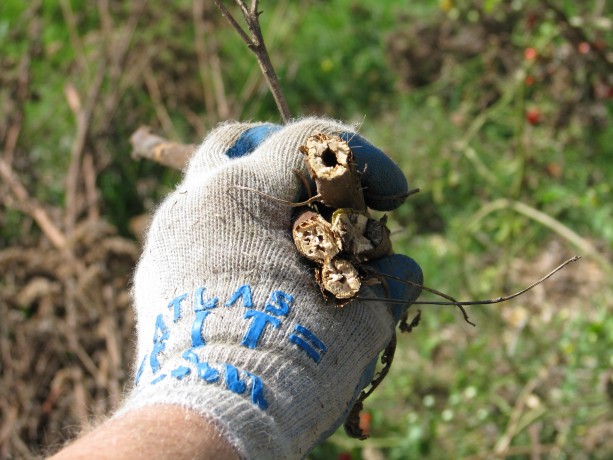
The stalks of fleabane are hollow… perfect homes for small bees! The stems were hollow and just the right size to house beneficial bees such as mason bees. This plant is certainly a boon for our first line of defense, our native insects.
We also chopped and dropped the tomato vines. Tomatoes like growing in the same place every year. With excellent soil biology – something we are still working on achieving with compost and compost teas – you don’t have to rotate any crops.

Slashed and dropped tomato and fleabane. We had also discovered in the last flood that extra water through this heavy clay area would flow down the pathway to the pond, often channeled there via gopher tunnels.
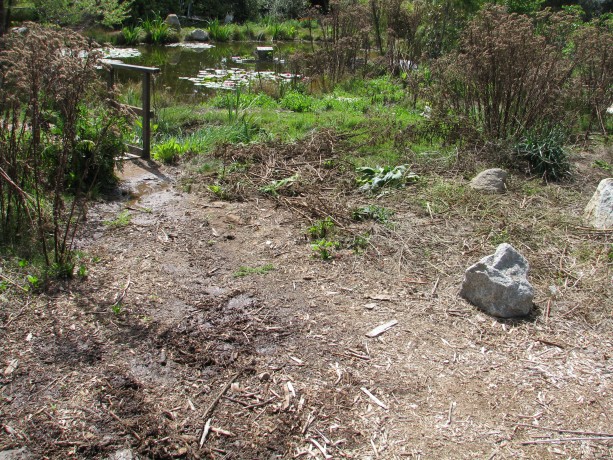
The pathway is a water channel during heavy rains. It needs fixing. We decided to harvest that water and add water harvesting pathways to the garden at the same time. We dug a swale across the pathway, perpendicular to the flow of water, and continued the swale into the garden to a small hugel bed.

Swale dug on contour through the pathway and across the guild. Hugelkultur means soil on wood, and is an excellent way to store water in the ground, add nutrients, be rid of extra woody material and sequester carbon in the soil. We wanted the bottom of the swale to be level so that water caught on the pathway would slowly travel into the bed and passively be absorbed into the surrounding soil. We used our wonderful bunyip (water level).
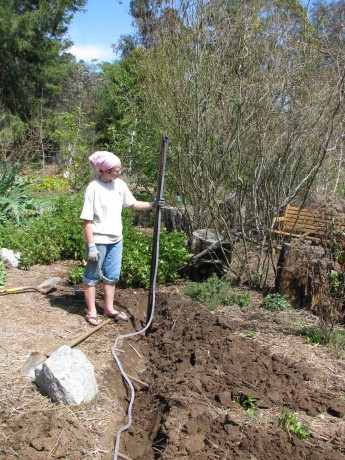
Using a bunyip to make the bottom of the swale level. Water running into the path will now be channeled through the guild. Because of the heavy clay involved we decided to fill the swale with woody material, making it a long hugel bed. Water will enter the swale in the pathway, and will still channel water but will also percolate down to prevent overflow. We needed to capture a lot of water, but didn’t want a deep swale across our pathway. By making it a hugel bed with a slight concave surface it will capture water and percolate down quickly, running along the even bottom of the swale into the garden bed, without there being a trippable hole for visitors to have to navigate. So we filled the swale with stuff. Large wood is best for hugels because they hold more water and take more time to decompose, but we have little of that here. We had some very old firewood that had been sitting on soil. The life underneath wood is wonderful; isn’t this proof of how compost works?
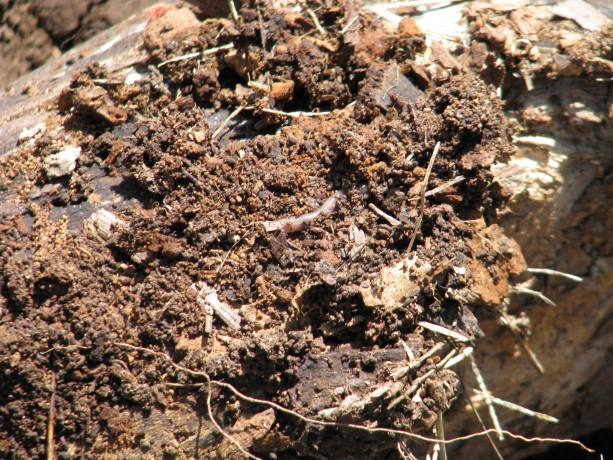
The activity under an old log shows so many visible decomposers, and there are thousands that we don’t see. We laid the wood into the trench.
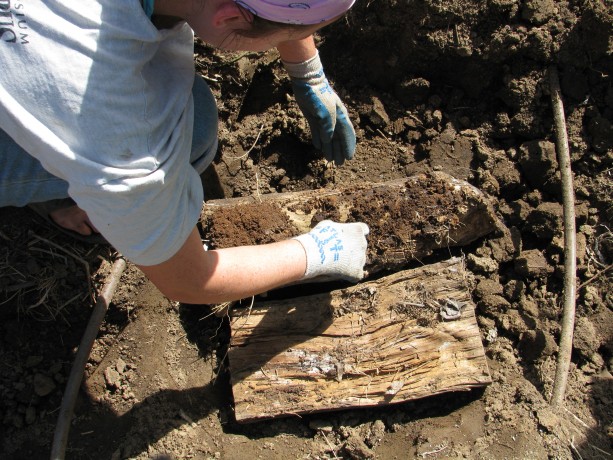
Placing old logs in the swale. If you don’t have old logs, what do you use? Everything else!
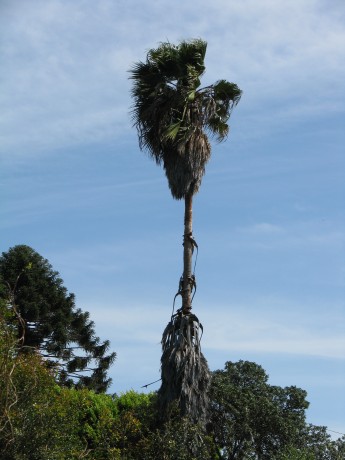
This giant palm has been a home to raccoons and orioles, and a perch for countless other birds. The last big wind storm distributed the fronds everywhere. We are wealthy in palm fronds.
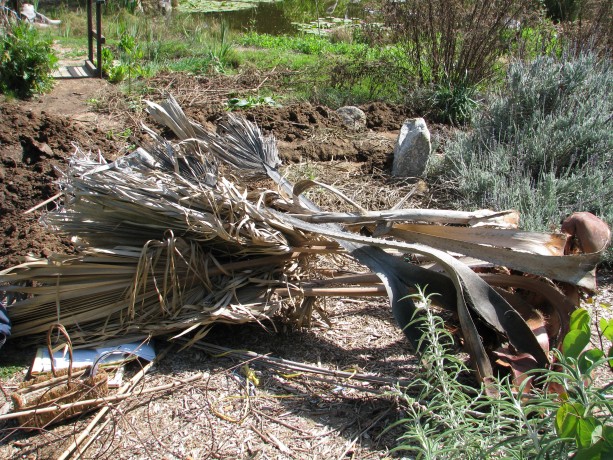
Three quick cuts (to fit the bed) made these thorny fronds perfect hugelbed components. We layered all sorts of cuttings with the clay soil, and watered it in, making sure the water flowed across the level swale.
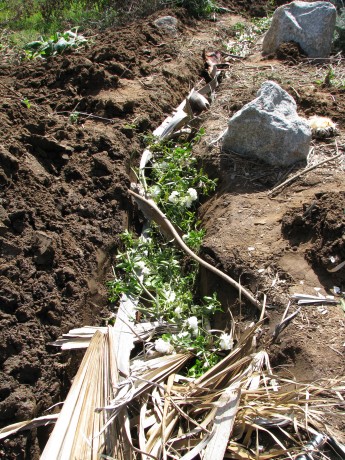
We filled the swale with fronds, rose and sage trimmings, some old firewood and sticks, and clay. As we worked, we felt as if we were being watched.
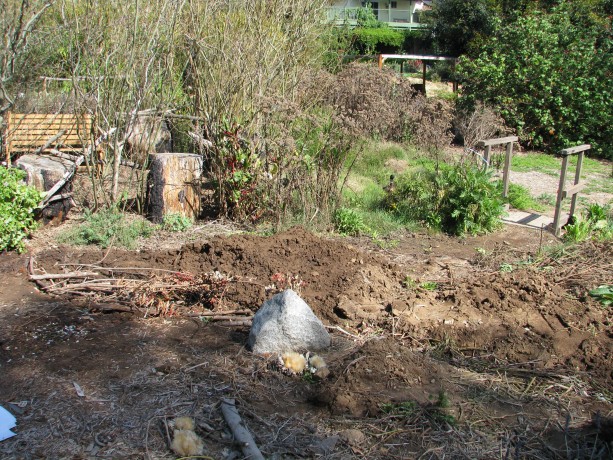
Can you spot the duck in this photo? Mr. and Mrs. Mallard were out for a graze, boldly checking out our progress. He is guarding her as she hikes around the property, leading him on a merry chase every afternoon. You can see Mr. Mallard to the left of the little bridge.
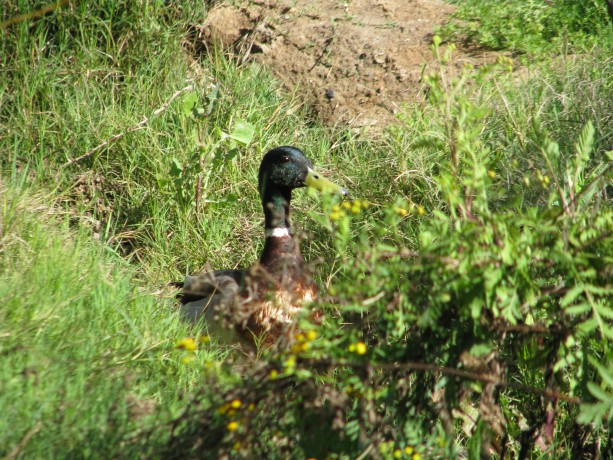
This male mallard and his mate, who is ‘ducked’ down in front of him, enjoyed grazing on weeds and watching we silly humans work so hard. After filling the swale, we covered the new trail that now transects the guild with cardboard to repress weeds.
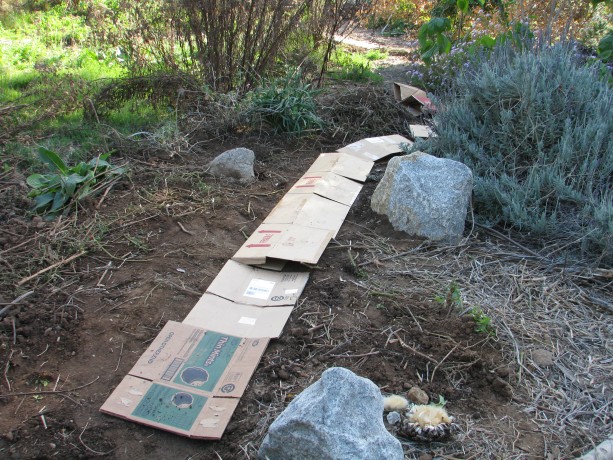
Cardboard laid over the hugelswale. Then we covered that with wood chips and delineated the pathway with sticks; visitors never seem to see the pathways and are always stepping into the guilds. Grrr!

The cardboard was covered with wood chips and the pathway delineated with sticks. Where the trail curves to the left is a small raised hugelbed to help hold back water. At this point the day – and we – were done, but a couple of days later we planted. Polyculture is the best answer to pest problems and more nutritional food. We chose different mixes of seeds for each of the quadrants, based on situation, neighbor plants, companion planting and shade. We kept in mind the ‘recipe’ for plant guilds, choosing a nitrogen-fixer, a deep tap-rooted plant, a shade plant, an insect attractor, and a trellis plant. So, for one quarter we mixed together seeds of carrot, radish, corn, a bush squash, leaf parsley and a wildflower. Another had eggplant, a short-vined melon (we’ll be building trellises for most of our larger vining plants), basil, Swiss chard, garlic, poppies, and fava beans. In the raised hugelbed I planted peas, carrots, and flower seeds.
In the back quadrant next to the mulberry I wanted to trellis tomatoes.
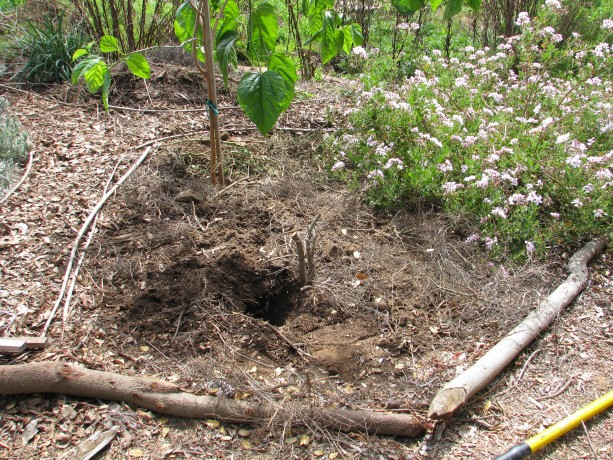
This quadrant by the mulberry needed a trellis for tomatoes. I’d coppiced some young volunteer oaks, using the trunks for mushroom inoculation, and kept the tops because they branched out and I thought maybe they’d come in handy. Sure enough, we decided to try one for a tomato trellis. Tomatoes love to vine up other plants. Some of ours made it about ten feet in the air, which made them hard to pick but gave us a lesson in vines and were amusing to regard. So we dug a hole and stuck in one of these cuttings, then hammered in stakes on either side and tied the whole thing up.
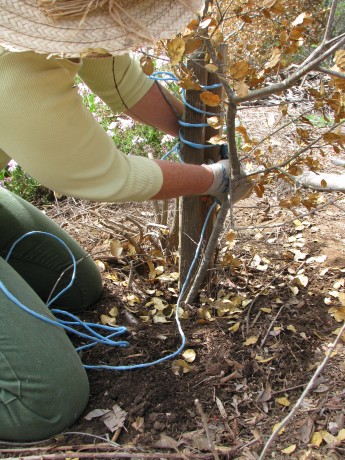
Tying the trunk to two stakes with twine taken from straw bales. Love the blue color! The result looks like a dead tree. However, the leaves will drop, providing good mulch, the tiny current tomatoes which we seeded around the trunk will enjoy the support of all the small twigs and branches, and will cascade down from the arched side.
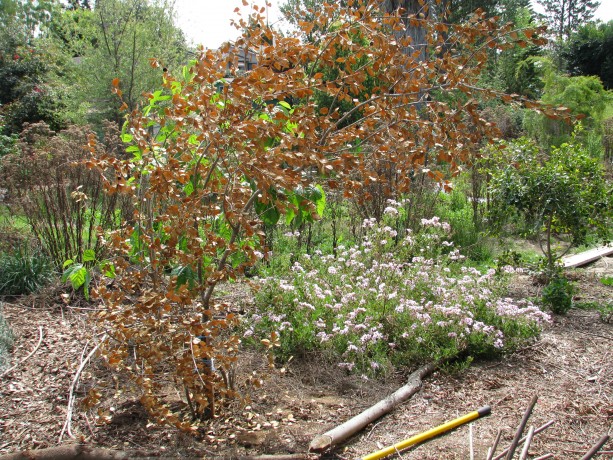
The ‘dead tree’ look won’t last long as the tomatoes climb over it and dangle close to the path for easy harvesting. We seeded the area with another kind of carrots (carrots love tomatoes!) and basil, and planted Tall Telephone beans around the mulberry trunk to use and protect it with vines. We watered it all in with well water, and can’t wait to see what pops up! We have so many new varieties from Baker Creek Heirloom Seeds and other sources that we’re planting this year! Today we move onto the next bed.
- Gardening adventures, Permaculture and Edible Forest Gardening Adventures, Ponds, Rain Catching, Soil, Water Saving
You Can Only Catch So Much Rain!
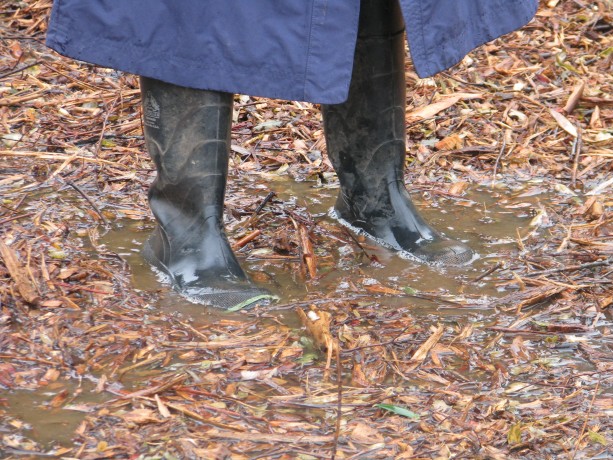 After a seriously dry and warm winter, last weekend we received most of our rain allotment over four days. Here in Fallbrook we received four inches. A long soaking rain would have been preferable, but I’m happy for what we received. Normally we receive downpours like cranky temper tantrums of the clouds that thunder down for a minute and then whimper away, but not this time.
After a seriously dry and warm winter, last weekend we received most of our rain allotment over four days. Here in Fallbrook we received four inches. A long soaking rain would have been preferable, but I’m happy for what we received. Normally we receive downpours like cranky temper tantrums of the clouds that thunder down for a minute and then whimper away, but not this time.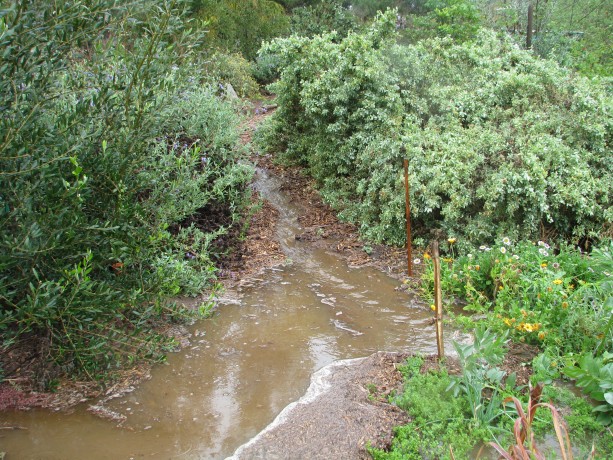
The pathway between the Mexican bush sage and quail bush became a river. Now we know where to put new swales. 
Water from the driveway was channeled down to the new veggie bed trenches, and filled them up. This storm had rain events where it would pour down buckets, and then become heavier and last for much longer than usual. The last storm of this type was back in December, 2010, which is when I lost chunks of property down into the streambed due to erosion across the property. Thanks to permaculture methods, the property received very little damage and no serious erosion.
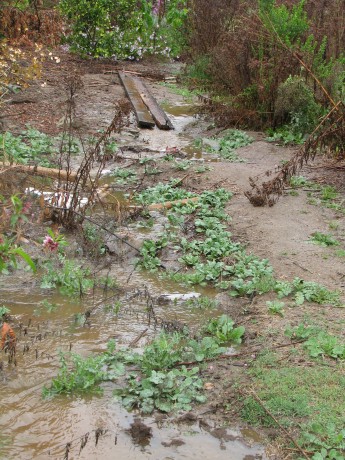
New temporary streams everywhere. This was a directed overflow from the ponds. If we had just received what had fallen on our property then we would have captured all of it. The downpours were so hard and long that we had tens of thousands of gallons of water flowing through from the street. My daughter and I left just after one of the last ginormous downpours and drove past a brown river running down the street and onto our property. It not only collected and flowed from other properties, but rain water was flowing from the cross street, Alvarado, down our street, through the neighbor’s property and through ours. It is amazing that we suffered as little damage as we did.
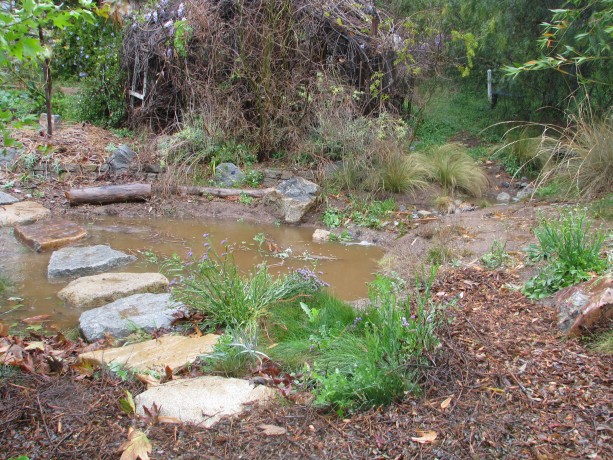
The large rain catchment basin worked beautifully, percolating well and slowing the flood. The rain catchment basins worked beautifully; the top one filled and percolated down many times, recharging the water table. Overflow systems worked well to channel water down an overflow pipe and into the streambed below. Water from the driveway was diverted to the long, level trenches we’d dug under our new ‘sunken’ veggie beds, and it worked well. It was good to see the overflows working, because there was no way in the world to capture the amount of water that flowed through this property. Oh, if only I could have! Let’s see: one inch of water falling in one hour on one acre is almost 27,000 gallons of water. I have 1.68 acres and we received four inches. That means that about 181, 440 gallons of water fell directly on my property alone. I couldn’t begin to calculate how much water flowed onto the property from the street and neighbor’s properties during the heavy rainfall times. Sigh. I’ll have to keep working on catching more! I’m water greedy!
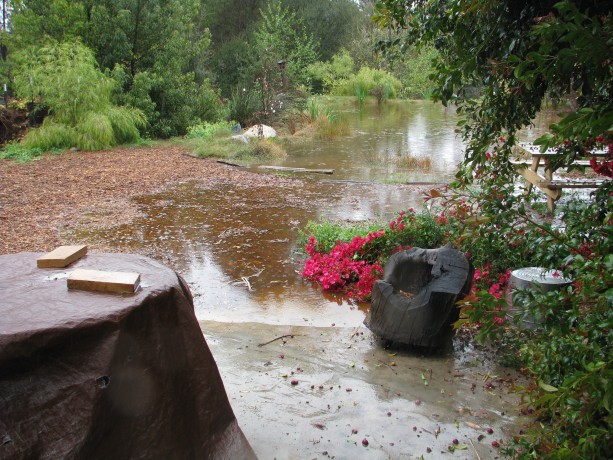
The big pond backed up to the cement slab where the cob oven sits! It wasn’t until the last day that water backed up and overflowed the cement channel, effectively removing mulch we’d just laid over plywood and cardboard on the pathways. One area, notorious for its squidgy clay when wet, emulated quicksand under the layer of mulch (the boot photo at the top).
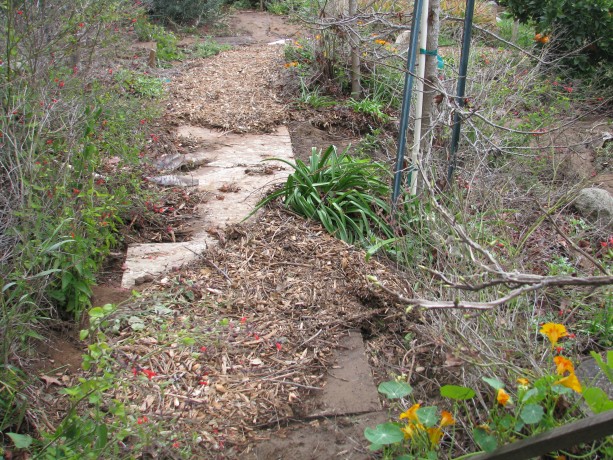
Plywood that had days before been topped with mulch. Repair work was time-consuming but not difficult, only we need more mulch! One of the great benefits of the overflow, however, is that it deposited sand and decomposed granite over the heavy clay in the beds. The storm helped amend the soil in these troublesome areas!

You can see the difference between the sandy silt that once belonged to our neighbors, deposited on the shiny thick clay of our garden bed. Thanks! In fact, outside of our gate where the street water flows to enter the property a lot of silt accumulated. We were out there with wheelbarrows today clearing it out and using it. It is a great mixture of sand, decomposed granite and organic materials! Beautiful stuff. We hauled it down the hill and used it to plant potatoes in milk crates, mixed with a little pigeon poo from our generous neighbors. I had been wondering where I’d be able to get the soil for those crates. We still have a lot left (more to collect, too, but it is heavy business) for other projects.
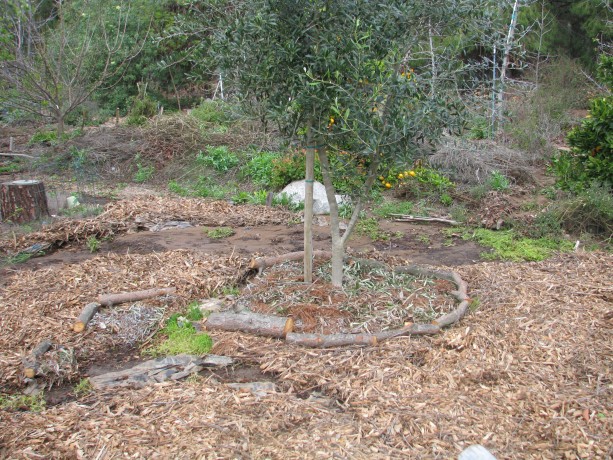
Just before the rains we’d covered this area in newspaper topped by mulch. You can see the river of water behind the tree and the shifted mulch in front. Strawberry plants under the olive were covered with debris. So on top of trying to catch up with the early spring here (did we even have winter??), we’ve been repairing the trails and making the walkways safe for the tours which have begun. It is a good lesson about where to place more swales and rain catchment basins for the next strange rain event. Since its March already, I don’t really have to worry about possible flooding for another twelve months or more!
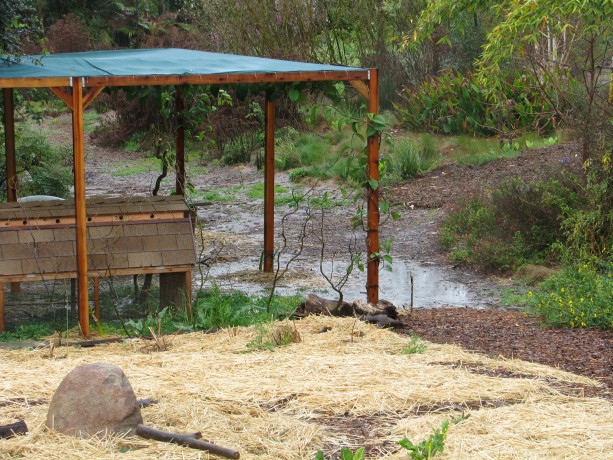
By the end of the four days everything overflowed, but not violently. Here we have a temporary pond by the Mock Pavilion. - Compost, Fungus and Mushrooms, Gardening adventures, Hugelkultur, Permaculture and Edible Forest Gardening Adventures, Rain Catching, Seeds, Soil, Vegetables, Water Saving, Worms
Planting Spores in the Garden

The mycelium is white in the sawdust and ready to go. If you remember the trenching, filling and designing the new veggie patch, then this post will make more sense to you.
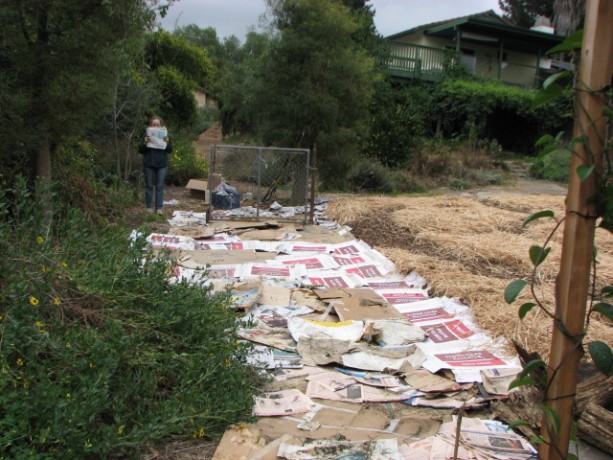
The next step was to cardboard the pathways where Bermuda grass has been taking over, then mulch them as well. The mulch makes it all look so nice!
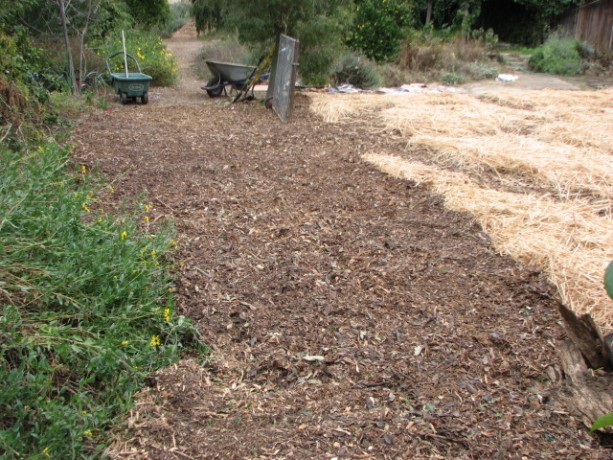
Covered with mulch, the cardboard is only a memory. Next it was time to plant. We’d already transplanted three-year old asparagus, and hopefully not shocked them so much that they won’t produce well this year. The flavor of fresh asparagus defies description.
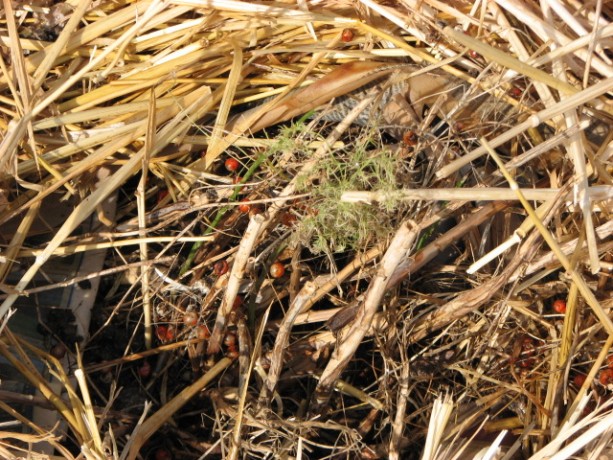
Asparagus popping up some feather shoots from its new home. The strawberry bed was older and completely taken over by Bermuda grass, so it all was buried and I purchased new organic and extremely reasonably priced bareroot strawberries.
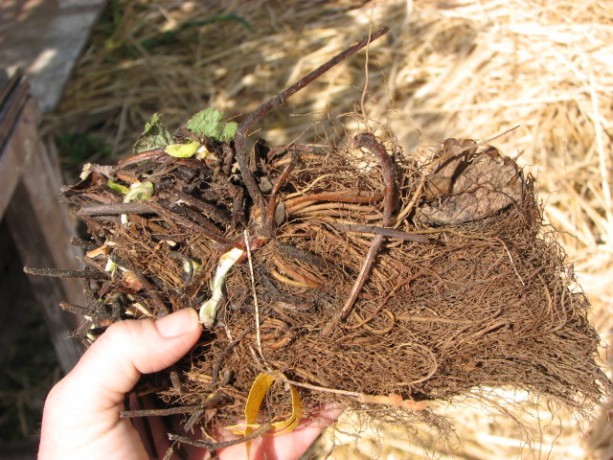
A bundle of twenty-five strawberries. I purchased two June-bearing types and three ever-bearing, heat-loving types, from www.groworganic.com. When they bloom this year we’ll have to nip off the buds so that next year when their roots have taken hold and fed the crown, we can have lots of strawberries.

Soaking the strawberry roots for a few minutes rehydrates them. We planted some in the asparagus bed, which will do nicely as groundcover and moisture retention around the asparagus, while the asparagus keeps the heat off the strawberries. Some we planted around the rock in the center of the garden. The rest will be planted around fruit trees as part of their guilds.
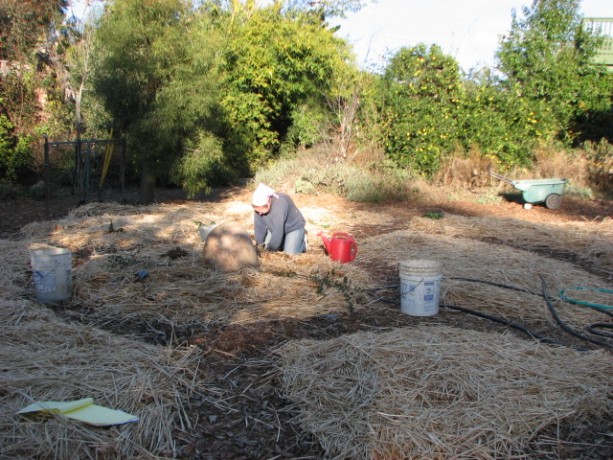
Strawberries surround the rock. We also planted rhubarb in the asparagus bed; these poor plants had been raised in the greenhouse for several months awaiting transplanting.
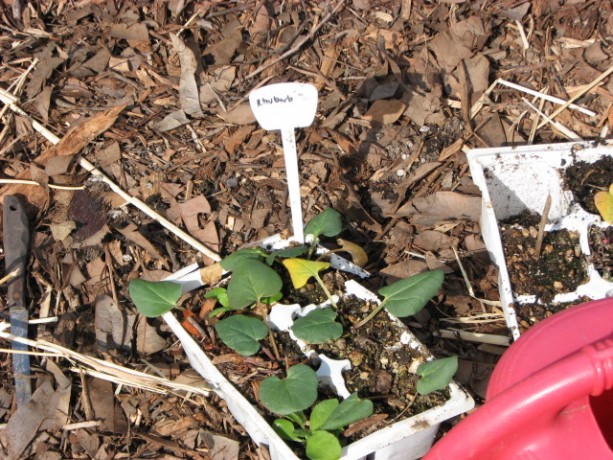
Rhubarb, really eager to be put in the ground. Hopefully the asparagus will protect them from the heat. I plan to raise more rhubarb from seed and plant them in other locations on the property, aiming for the coolest spots as they don’t like heat at all.
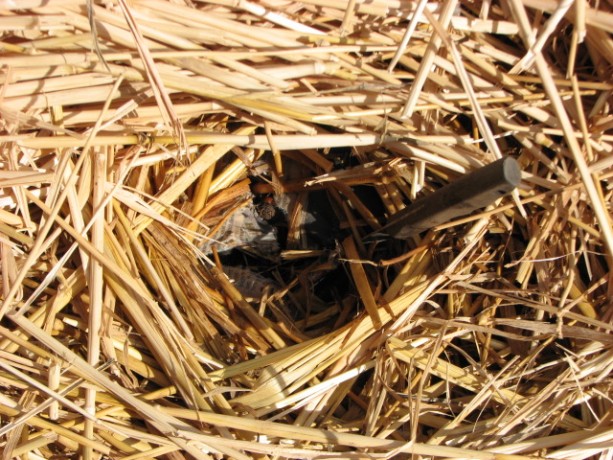
With a strong knife (weak blades may snap) cut a cross in wet cardboard the pull aside the edges. The way to plant through cardboard is to make sure that it is wet, and using a strong knife make an x through the cardboard. Use your fingers to pull the sides apart. Stick your trowel down and pull up a good shovel full of dirt (depending on how deeply your plant needs to go.
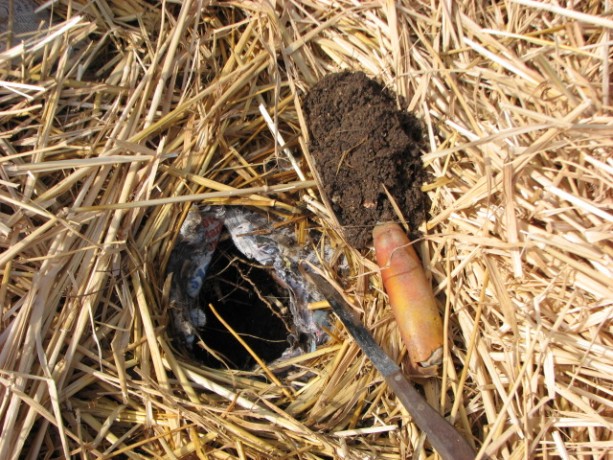
Insert a trowel through the hole and scoop out some dirt. The base of plants and the crowns of strawberries should all be at soil level. Seeds usually go down three times their size; very small seeds may need light to germinate). Gently plant your plant with a handful of good compost, then water it in. You won’t have to water very often because of the mulch, so check the soil first before watering so that you don’t overwater.
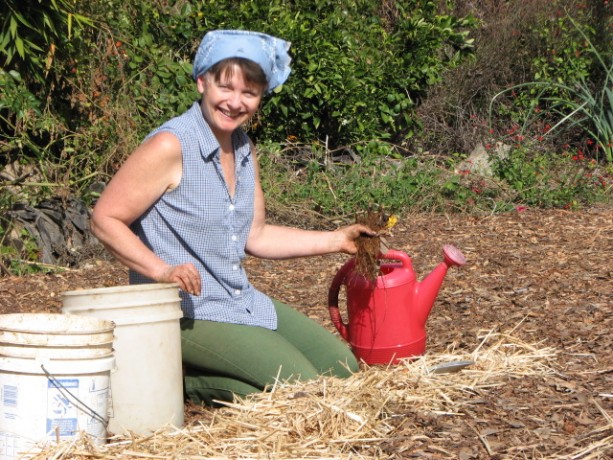
Don’t forget to water in the plants! For the first time in years I ordered from the same source Jerusalem artichokes, or Sunchokes as they’ve been marketed. They are like sunflowers with roots that taste faintly like artichoke. We planted some of them in one of the quadrants, and the rest will be planted out in the gardens, where the digging of roots won’t disturb surrounding plants.
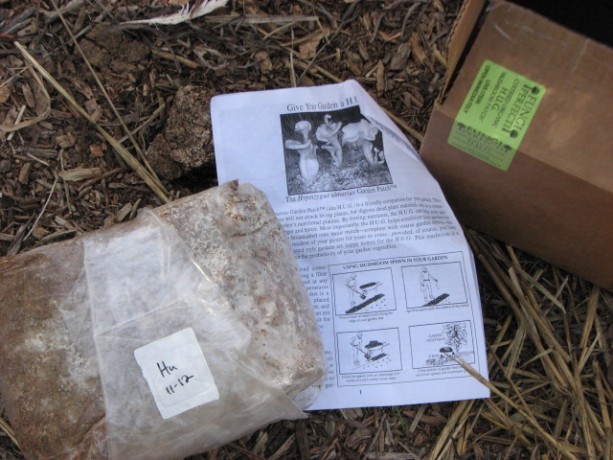
The oyster mushroom kit, or H.U.G. You’ll have to visit Fungi Perfecti to read up on it. Most excitingly, we’ve purchased mushroom spores from Fungi Perfecti, which is Paul Stamet’s business, the man who wrote Mycelium Running and several other books about growing mushrooms for food and for health. We bought inoculated plugs, but that will be another post. Almost as exciting are the three bags of inoculated sawdust to spread in the garden! They sell an oyster mushroom that helps digest straw and mulch, while boosting the growth of vegetables and improving the soil. You also may be able to harvest mushrooms from it! Talk about a wonderful soil solution, rather than dumping chemical fertilizers on the ground!
We’d already covered our veggie beds with wet cardboard and straw.
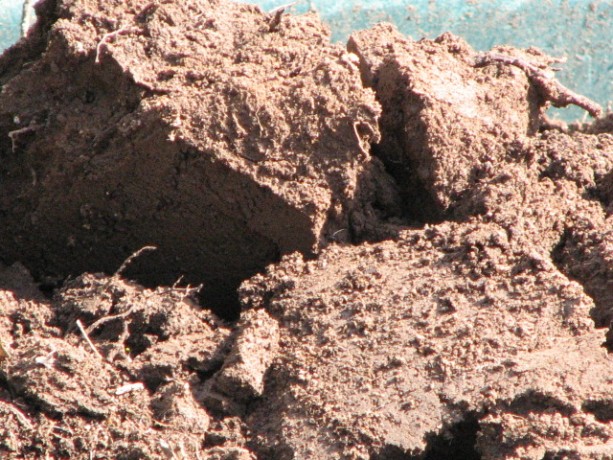
Really good soil from what is now a mulched pathway. To give the mycelium a good foundation I dug up good soil from one of the field beds, which needed an access path through the middle. By digging out the path I created new water-holding swales, especially when filled with mulch.
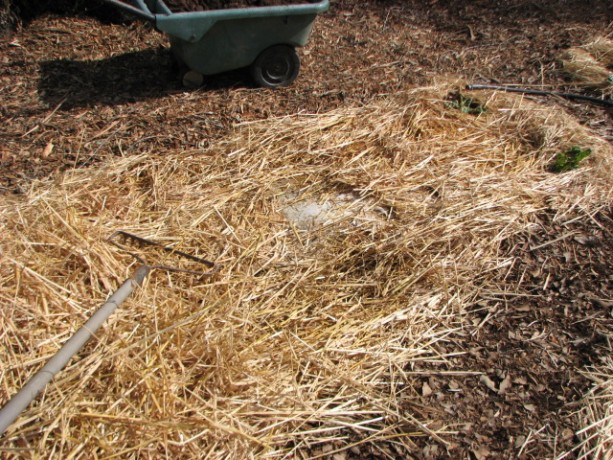
We pulled aside the straw. In the veggie garden we raked back the straw and lightly topped the wet cardboard with soil. On top of that we sprinkled the inoculated sawdust.
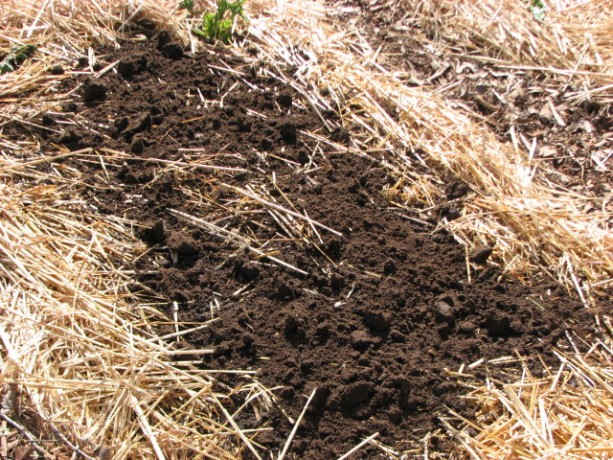
Good soil over cardboard. On top of that we pulled back the straw and watered it in.
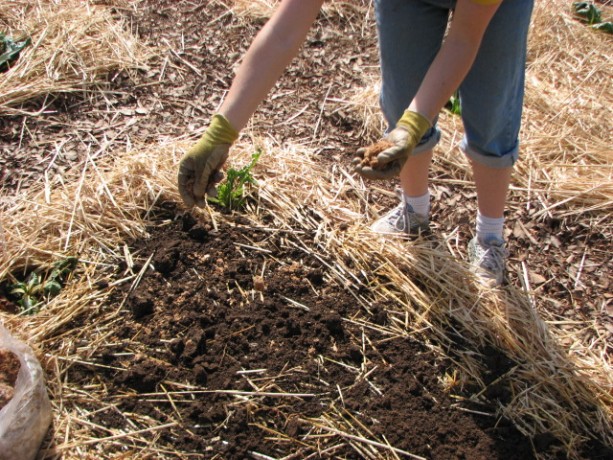
Sprinkling spore-filled sawdust over the soil. The fungus will activate on the wet soil, eat through the cardboard to the layers of mushroom compost and pidgin poo underneath that and help make the heavy clay beneath richer faster.
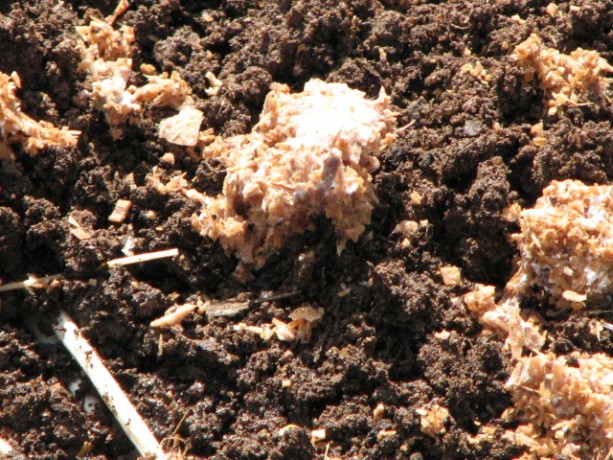
The fungi will immediately begin to colonize the wet soil. We treated the two top most beds which have the worst soil, the sunchoke bed and the asparagus bed. In four to six weeks we may see some flowering of the mushrooms, although the fungus will be working even as I sit here. There are several reasons why I did this. One, it is just totally cool. Secondly, there is no way for me to purchase organic straw. By growing oyster mushrooms in it, I’m hoping the natural remediation qualities of the oyster fungus will help cleanse the straw as it decomposes. Oyster mushrooms don’t retain the toxins that they remove from soil and compost, so the mushrooms will still be edible. Fungus will assist rebuilding the soil and give the vegetables a big growing boost. I know I’ve preached that vegetables like a more bacterial soil rather than fungal. This is true, except that there are different types of fungus. If you put wood chips in a vegetable bed, you’ll activate other decomposing fungus that will retard the growth of your tender veggies; the same wood chips around trees and woody plants will help them grow. However these oyster mushrooms will benefit your veggies by quickly decomposing compost and making the nutrients readily available to the vegetables. Their hyphae will help the veggie’s roots in their search for water and nutrients, too.
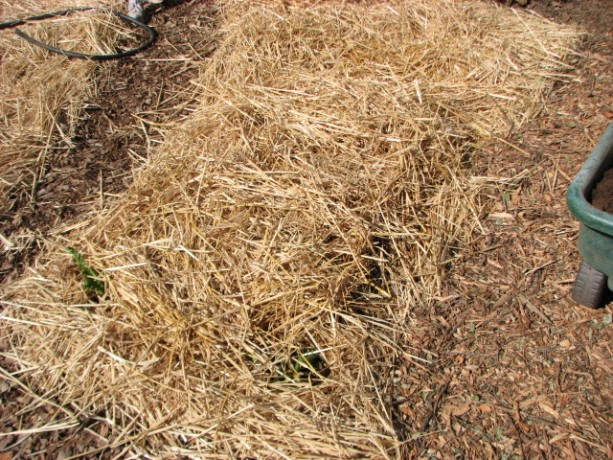
Straw is over the top and watered. We can continue to plant in the beds as the fungus does its magic. The other two bags of inoculated spores are for shaggy mane and garden giant, which we’ll find homes for in compost under trees. More on that as we progress. It is so nice to be planting, especially since these are perennial plants where the most work is being done now. Now we just need some rain!
- Compost, Gardening adventures, Hugelkultur, Permaculture and Edible Forest Gardening Adventures, Rain Catching, Soil, Water Saving
The Sunken Bed Project… Finis!
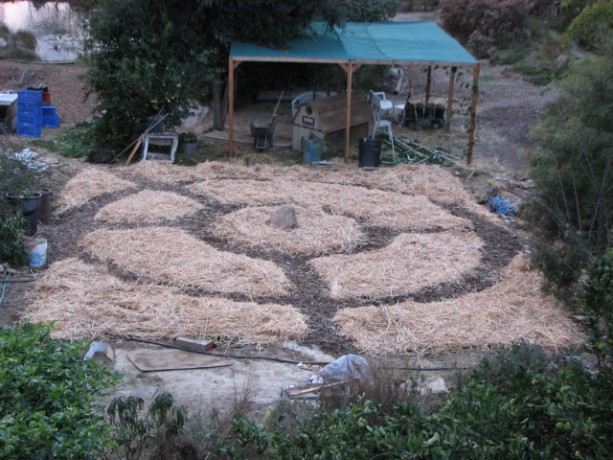
Maybe they can see this from space? To take up where we left off in this exciting saga, we had the hugelkultur trenches buried, the pattern outlined in gypsum, and a boulder moved. On top of the beds I spread the cleanings of a pigeon coop, courtesy of our good friends and neighbors who raise and rescue many pigeons.
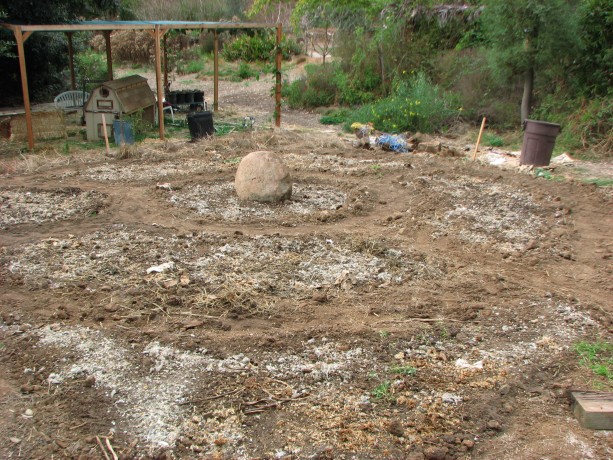
Pigeon poo and coop gleanings all over the garden beds. Yum! The high nitrogen poo, feathers, and leftover pigeon peas and other food items will make a wonderful breakfast for microbes. On top of that I spread a pickup truck bed full of mushroom compost. Jacob was nice enough to clean out his truck and help me get a load. The nearby mushroom farm raises shiitake and button mushrooms on logs of compressed sawdust. This is a high fungal compost, and slightly acidic. Since we have a high alkaline soil, this is okay.
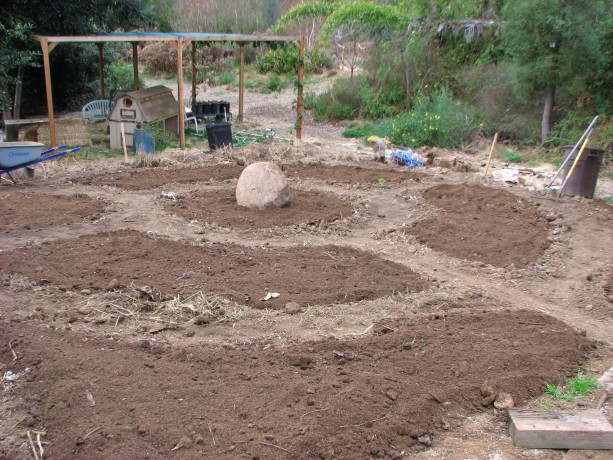
The garden beds covered with mushroom compost. After the compost begins to make its final decomposition, the worms thrive in it. I managed to wheelbarrow down the entire load and spread it just before we had the first rain event of the year…less than 1/4″, but enough to give the garden a small soaking.
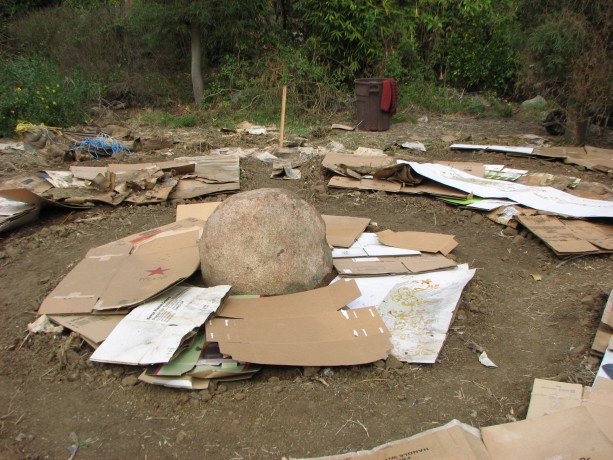
Cardboard is on all the garden beds. How nice to clean up all that cardboard and newspaper that we’ve been collecting! Today my daughter and I started in on the final treatment. We covered all the beds with cardboard, and all the pathways with newspaper. This thin layer will hold in moisture, and help retard the growth of the dreaded Bermuda grass.
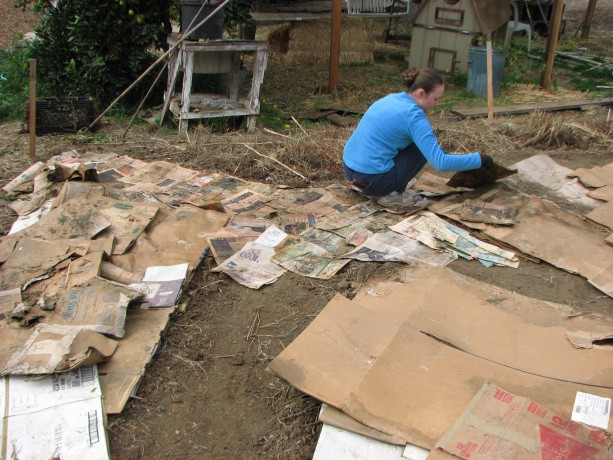
Spreading damp newspaper on the pathways. I’m really hoping so, anyway. Another small storm was blowing in for tonight, scattering our newspapers although we wet them down thoroughly. We’re still using water from the 700-gallon tank that catches water from the house’s raingutters. We’re trying to use some up so that fresh water can enter the tank with this storm.
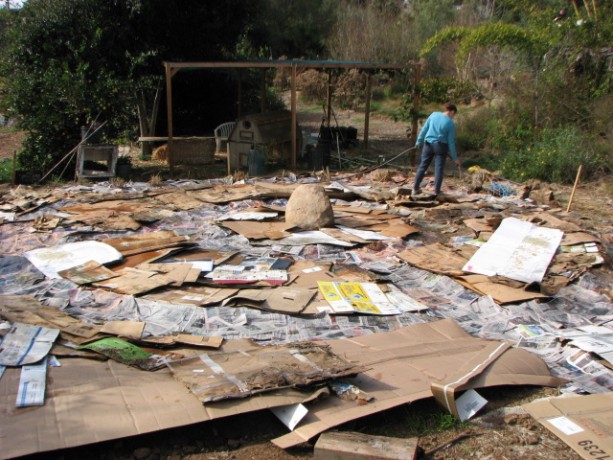
Watering down the newspaper with rainwater from the tank to keep the wind from undoing all our work, and starting the decomposition process. Although we were both very tired and getting cold, we needed to cover the paper. I hauled down about fifteen wheelbarrows full of mulch; this had been dumped in the driveway courtesy a landscaper with a chipper. Miranda spread the mulch over all the pathways, which looked just great.
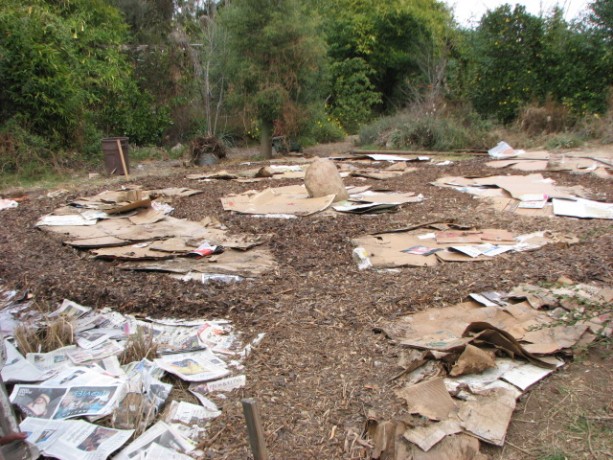
Paths covered in mulch. We almost stopped there, but I was driven to finish this project today. We pitchforked used straw from out of the Fowl Fortress, broke open some other bales, and mulched the garden beds heavily with the straw. And…. we’re done! Yipee! The rain tonight will give it all a good soak, and soon we can begin planting in our snazzy new garden beds.

The beds covered in straw! Hurray! I admit that I thought the beds would look more sunken, but with three 2′ deep x 30′ long trenches underneath there is a lot of underground moisture for the topsoil to absorb. Also the beds are below the pathways, but with the height of the cardboard and straw they don’t look it. With the garden on a slope we had to make some adjustments.
The next exciting project that we’ve already begun working on is growing mushrooms! Stay tuned.
- Compost, Gardening adventures, Hugelkultur, Permaculture and Edible Forest Gardening Adventures, Rain Catching, Soil, Vegetables, Water Saving
The Pros and Cons of Raised Beds
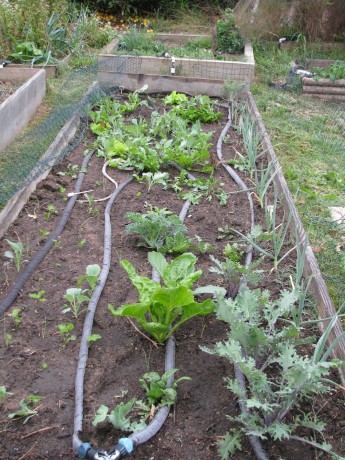
The raised beds. Raised garden beds can be wonderful things. They also can be inappropriate. I’m in the process of taking ours down and replacing them with… well, I’ll describe it later on. Let’s get back to the pros and cons of raised beds.
Here are some of the pros:
Raised beds look just great. They are neat, tidy, organized and restful to the eye.
If raised high enough they are accessible to those who can’t work on the ground or bend over, and to those who are non-ambulatory.
If lined with hardware cloth they keep gophers and mice from tunneling under your food and making it magically disappear.
They help with some weed control.
If you live in a rainy area, they help with drainage.
If you have miserable soil, you can garden anywhere by building a raised bed without having to dig.
If you live in a cold area, depending upon what materials you use for the sides of the raised beds you can tap into the thermal heat and have warmer soil longer.
You can build reusable covers for the beds and turn them into cold frames, or shade structures.
Now here are some of the cons:
You need to fill raised beds with a lot of soil, and if you have to buy it, that is a large expense. The soil will compact and disappear over the course of a year, so you have to keep topping up the beds to keep the soil level high. Heavy work that is expensive.
Wire underneath the raised beds will last a few years and then will be compromised by rodents, so the bed will have to be emptied and rewired if rodents are a problem.
If you live in a warm, dry climate, the sides of the raised bed acts like a clay pot. It will wick moisture from the dirt and heat the dirt up so that plant roots around the perimeter will cook.
If you live in a warm climate you have to pour on the water because of the point mentioned above; a raised bed dries out much more quickly than in-ground gardens.
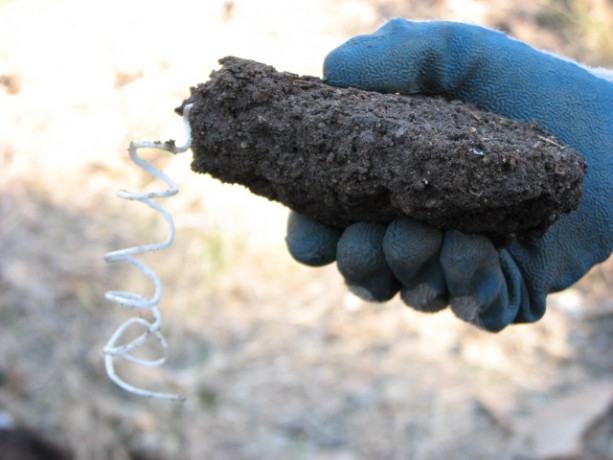
We are wealthy in clay. A Bermuda grass root hangs like a piglet’s tail from this clump. I built raised beds from old bookshelves many years ago, and that was my only veggie garden on the property as I raised my children. I’d grown plants in-ground before that, trenching and turning, and losing the fight against gophers and Bermuda grass. The raised beds were lined with wire. For awhile it worked, but the Bermuda grass took over and infiltrated all the beds. The wire began to rot and rodents chewed away at the sweet potatoes. Worst of all, the soil level would decrease, and since the beds weren’t very deep, then root veggies would grow into the wire and I’d lose half of them as they broke off during the harvest. I couldn’t keep up with refilling the beds. I composted in place, buried wood and vines, and that worked well, but I still needed to add compost. The beds drank up water during our long, hot summers.
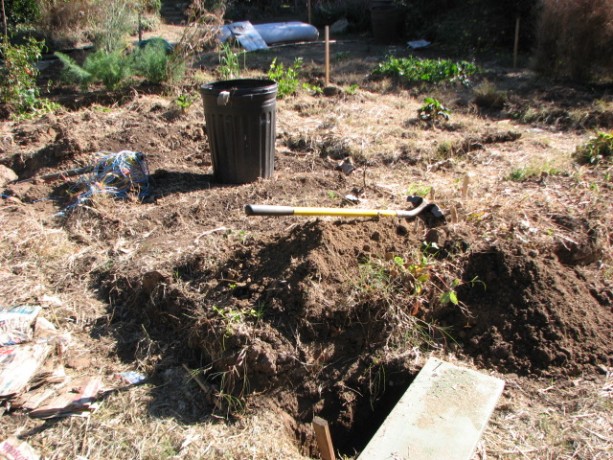
The trenching begins. This summer I realized that I was using a gardening technique that was best suited to rainy climates. Here in the dry Southwest, a traditional gardening method was to plant in sunken beds. We need to capture water, not make it run off. Also, the Bermuda grass became so invasive that I realized that only sheet mulching would make any difference in controlling it.
Of course I decided that my daughter and I couldn’t possibly have an easy winter, but must rip out the beds and start digging.
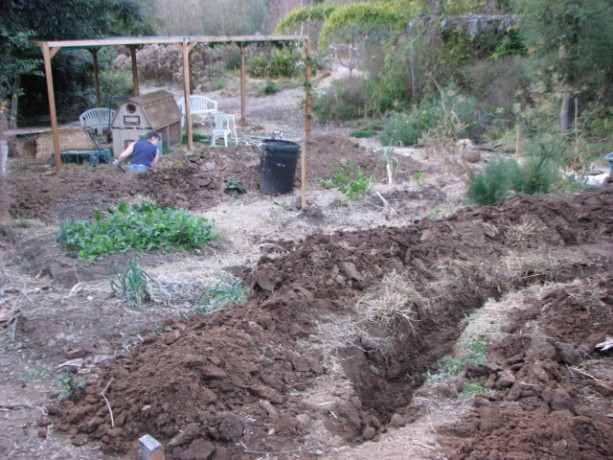
In the trenches. I’m an advocate of no-dig gardening; however sometimes you have to dig bad soil to create good soil. The no-dig policy can happen once the infrastructure is in place. So here’s what I’m planning on doing: I’m combining hugelkultur with sunken gardens and sheet mulching to create what I hope will be a veggie garden with a much lower water consumption, and weed-free.
First we determined the direction of water flow down the hill, and planned on creating trenches that would capture that water. The trenches, or swales, would need to be level on the bottom so that any water flowing in from the downhill side, would travel all along the swale even to the drier side, where the surface soil was higher. We created a bunyip to estimate the difference in slope between the top and bottom of the garden. Although I had drawn up intricate plans for a square garden, that shape just wouldn’t work so we went with a rectangle. Then we began to dig. The first ten inches wasn’t bad, but after that we hit clay. I had to buy a mattock. I also ended up icing my back for a couple of days. Some of the clay we’ll save for use on any future earthworks we may want to do, and some we’re saving for an artist friend.
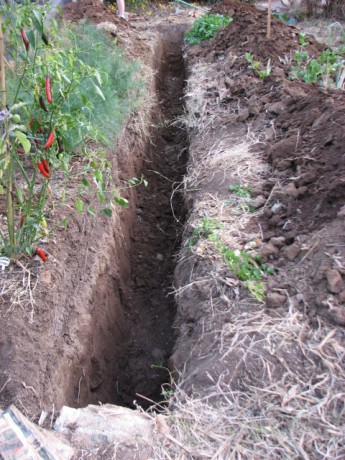
The soil was good for about ten inches, then we hit clay. The trenches are two feet deep, and about one to one and a half feet wide. It is amazing how you start out large, and then after a few very hot afternoons scraping clay and throwing it up and over four feet, the trenches become more narrow. My plan is to fill the bottom foot of the trenches with old wire, wood, branches, old textiles and other biodegradable debris. The old wire will rot, and will also help repel gophers. On top of all this will be layered some of the clay, and watered in with compost tea brewed in the 700-gallon water tank that is full of rainwater from the last rain (two months ago!). On top of that will be good soil, smoothed below the surrounding surface level. Water from the road will be diverted into the swales, which will allow it to flow across the garden and be absorbed by the fill materials. But what about the Bermuda grass? There isn’t a mountain of cardboard all over my garage for nothing! The entire garden will be sheet mulched, and all veggies will be planted through the cardboard and newspaper. The existing asparagus bed will need to be carefully relocated, but everything else can either be harvested or dug under.
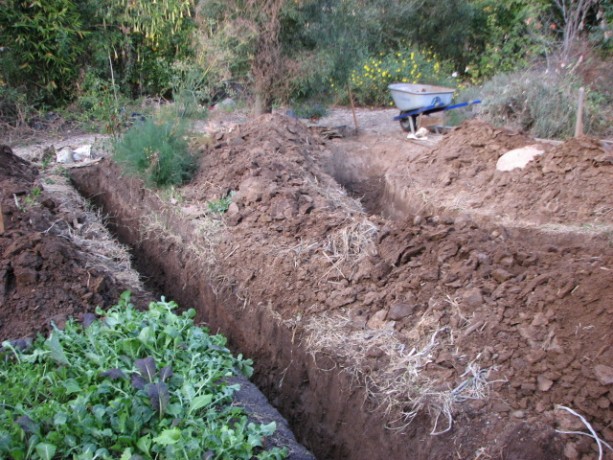
These first two trenches will collect rainwater from the pathways and channel it the length of the garden. That’s the plan, anyhow. I’ll let you know how it goes.
